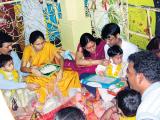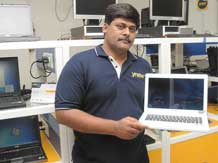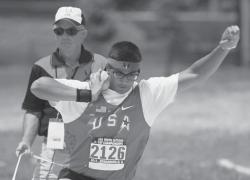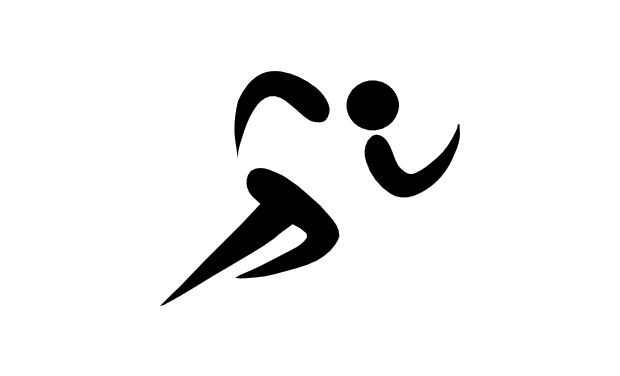
Schools have reopened and children are back in their classrooms. But even before they get enrolled in a school, there is one place in Andhra Pradesh that they prefer to visit.
But getting an opportunity to take part in the Aksharabhyasam ritual at the Gnana Saraswati temple in Basara town in Nizamabad district, about 200 km from Hyderabad, is quite tough. Hundreds of parents bring their wards to perform the traditional pooja of making children write their first alphabet on slates in the presence of goddess of knowledge, Gnana Saraswati.
Legend says that Aksharabhyasam ensures education without any breaks and distinction throughout the academic career of young ones.
It is believed that Maharishi Vyasa and his disciples and sage Suka decided to settle down in a cool and serene atmosphere after the Kurukshetra war. In the quest for a peaceful abode, Vyasa came to Dandakaranya forest and pleased with serenity of the region selected a place which is now called as Basara. After ablutions in the river Godavari, Vyasa used to bring three fistfuls of sand and place it in small heaps on the banks and made images of Sharada, Lakshmi and Gowri with his mystic power and later conducted prayers.
This idol of Sharada (Saraswati) made out of sand is now smeared with turmeric. Eating a little bit of this turmeric paste, it is believed, will enhance one’s wisdom and knowledge. Special poojas and celebrations are held at the temple
during Maha Shivaratri, beginning 15 days before (Vasantha Panchami) and continuing three days after the festival. Devi Navarathrulu is celebrated for 10 days during Dasara. Since Maharishi Vyasa spent considerable time in prayers, the place was then called Vasara which later became Basara.
“Aksharabhyasam is to be performed when a child completes two years and is turning three. As the mind of the child develops and is keen to learn various things in the world, Aksharabhyasam is performed in the third year as an initiation to start formal education,” says one of the temple priests Muralidhara Sharma. The literal meaning of Akshara is alphabet and the meaning of Abhyasam is practice. Hence, this function is considered a pre-requisite in the Hindu religion before the child starts formal
education in a school.
There are four important days in the year when one can perform Aksharabhyasam function at Basara Sree Gnana Saraswati Temple– Vasanta Panchami also known as Siri Panchami, the fifth day after Amavasya (no moon day) in the Hindu month of Maagha marks the advent of spring season. The importance of Basant Panchami is that it is on this day, Saraswati is specially worshipped and children are first taught to write the alphabet. Vijaya Dasami is another day auspicious to conduct Aksharabhyasam.
Another important day for celebrating Aksharabhyasam is Vyasa Pournami (Guru Pournami) which falls on full moon day in the Hindu month of Aashadam. This day is the birthday of Veda Vyasa. Shravana Pournami (Raakhi Pournami) is also considered an auspicious day and people throng Basara temple for performing Aksharabhyasam of their children.
One must carry at least half a kilo of rice along with them to spread on a slate at the time of Aksharabhyasam, turmeric powder and kumkam (vermillion) for use while performing pooja. Other materials like slate, piece of chalk, coconut, flowers and garlands are available at the temple premises.
At Basara, on the four important days there will be long queues and devotees will have to wait for hours for their turn. Devotees try to reach the temple as early as possible to get the first slot for the ritual. In the masse celebration, families will sit in front of the main deity. And the temple priest will give instructions.
“Remember to carry enough snacks like biscuits and water bottles as the children get vexed in the long lines. If possible, carry a couple of favourite toys, just to keep the child preoccupied while waiting in the queue,” suggests D Venumadhav who came from Hyderabad with his son.
There are two options for performing the function at the temple premises– one in front of the main deity and for which the ticket cost is Rs 500. While the other option is in any place in the temple premises outside the sanctum sanctorum and the ticket price is Rs 50.
The temple at Basara is also the abode of Goddess Lakshmi and Kali. It is said that these temples belong to the Chalukya period. The presiding deity, Gnana Saraswati Devi, is in a seated position with a Veena in hand. Adjacent to it is the shrine of Mahalakshmi and a little distance away, on the eastern side is the Maha Kali temple.
There is a cave some 100 metres from the temple and it is believed that devout Narahari Maluka performed rigorous penance in that place.
There is a four-sided monolith rock called Vedavati, which produces different sounds on each side when struck. It is said to contain jewels of Sita Devi. There are eight pushkarnis spread across the village known as Indra Teeratham, Surya Teeratham, Vyasa Teeratham, Valmiki Teeratham, Vishnu Teeratham, Ganesha Teeratham, Puthra Teeratham and Shiva Teeratham.
The most important festivals celebrated at Basara are Maha Shivaratri (February-March) and Devi Navaratrulu (September-October) and on both the occasions about 10,000 pilgrims visit the place from all parts of Andhra Pradesh and Maharashtra.
source: http://www.deccanherald.com / Deccan Herald / Home> Special Features / JBS Umanadh / July 13th, 2013




